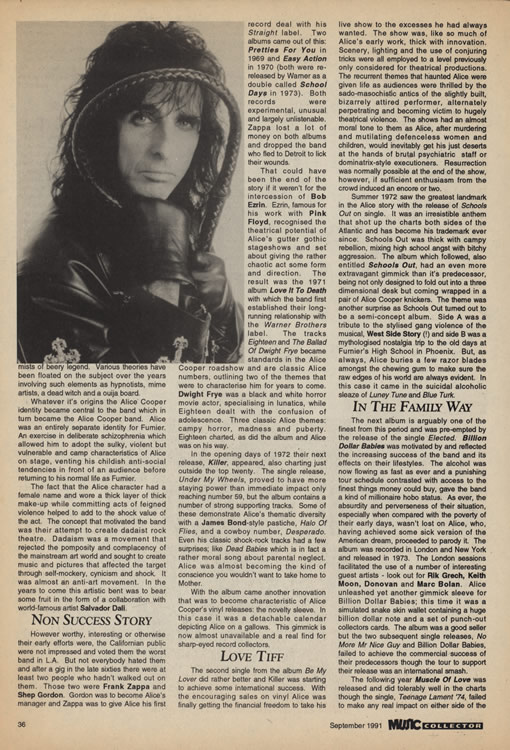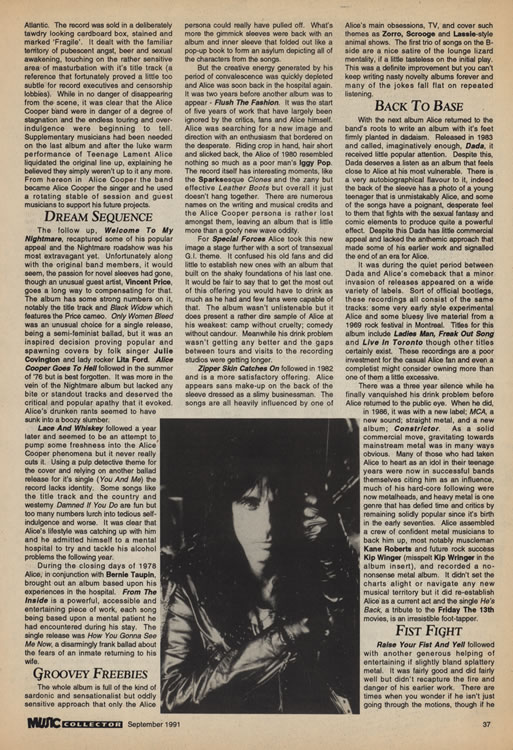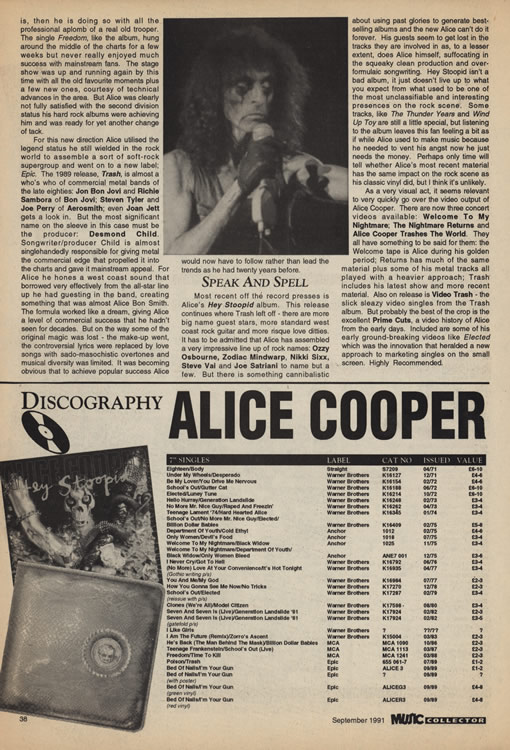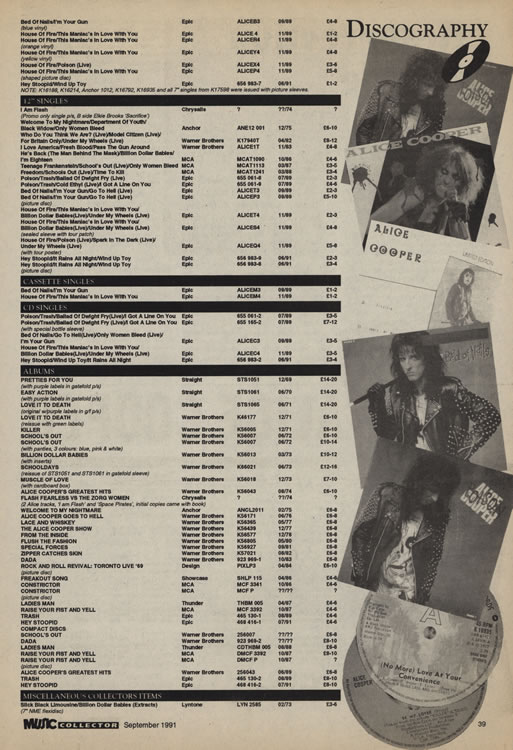Article Database
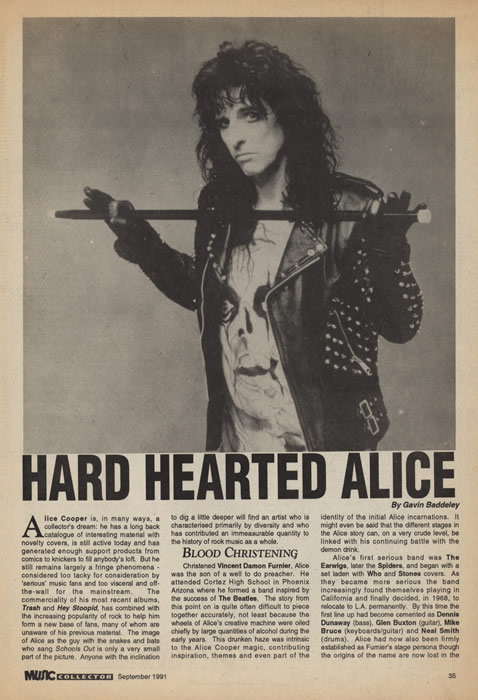
Music Collector
September 1991
Hard Hearted Alice
Alice Cooper is, in many ways, a collector's dream: he has a long back catalogue of interesting material with novelty covers, is still active today and has generated enough support products from comics to knickers to fill anybody's loft. But he still remains largely a fringe phenomena - considered too tacky for consideration by 'serious' music fans and too visceral and off-the-wall for the mainstream. The commerciality of his most recent albums, Trash and Hey Stoopid, has combined with the increasing popularity of rock to help him form a new base of fans, many of whom are unaware of his previous material. The image of Alice as the guy with the snakes and bats who sang School’s Out is only a very small part of the picture. Anyone with the inclination to dig a little deeper will find an artist who is characterised primarily by diversity and who has contributed an immeasurable quantity to the history of rock music as a whole.
Blood Christening
Christened Vincent Damon Furnier Alice was the son of a well to do preacher. He attended Cortez High School in Phoenix Arizona where he formed a band inspired by the success of The Beatles. The story from this point on is quite often difficult to piece together accurately not least because the wheels of Alice's creative machine were oiled chiefly by large quantities of alcohol during the early years. This drunken haze was intrinsic to the Alice Cooper magic contributing inspiration, themes and even part of the identity of the initial Alice incarnations. It might even be said that the different stages in the Alice story can, on a very crude level, be linked with his continuing battle with the demon drink.
Alice's first serious band was The Earwigs, later the Spiders, and began with a set laden with Who and Stones covers. As they became more serious the band increasingly found themselves playing in California and finally decided, in 1968, to relocate to L A permanently. By this time the first line up had become cemented as Dennis Dunaway (bass), Glen Buxton (guitar) Mike Bruce (keyboards/guitar), and Neal Smith (drums). Alice had now also been firmly established as Furnier's stage persona though the origins of the name are now lost in the mists of beery legend. Various theories have been floated on the subject over the years involving such elements as hypnotists, mime artists, a dead witch and a ouija board.
Whatever it's origins the Alice Cooper identity became central to the band which in turn became the Alice Cooper band. Alice was an entirely separate identity for Furnier. An exercise in deliberate schizophrenia which allowed him to adopt the sulky, violent but vulnerable and camp characteristics of Alice on stage, venting his childish anti-social tendencies in front of an audience before returning to his normal life as Furnier.
The fact that the Alice character had a female name and wore a thick layer of thick make-up while committing acts of feigned violence helped to add to the shock value of the act. The concept that motivated the band was their attempt to create dadaist rock theatre. Dadaism was a movement that rejected the pomposity and complacency of the mainstream and sought to create music and pictures that affected the target through self-mockery cynicism and shock. It was almost an anti-art movement. In the years to come this artistic bent was to bear some fruit in the form of a collaboration with world-famous artist Salvador Dali.
Non Success Story
However worthy, interesting or otherwise their early efforts were, the Californian public were not impressed and voted them the worst band in L.A. But not everybody hated them and after a gig in the late sixties there were at least two people who hadn't walked out on them Those two were Frank Zappa and Shep Gordon. Gordon was to become Alice's manager and Zappa was to give Alice his first record deal with his Straight label .Two albums came out of this: Pretties For You in 1969 and Easy Action in 1970 (both were re-released by Warner as a double called School Days in 1973). Both records were experimental, unusual and largely unlistenable. Zappa lost a lot of money on both albums and dropped the band who fled to Detroit to itch their wounds.
That could have been the end of the story if it weren't for the intercession of Bob Ezrin. Ezrin famous for his work with Pink Floyd, recognised the theatrical potential of Alice's gutter gothic stage shows and set about giving the rather chaotic act some form and direction. The result was the 1971 album Love It To Death with which the band first established their long-running relationship with Warner Brothers label. The tracks Eighteen and The Ballad Of Dwight Fry became standards in the Alice standards in the Alice Cooper roadshow and are classic Alice numbers, outlining two of the themes that were to characterise him for years to come. Dwight Frye was a black and white horror movie actor, specialising in lunatics, while Eighteen dealt with the confusion of adolescence. Three classic Alice themes: campy horror, madness and puberty. Eighteen charted, as did the album and Alice was on his way. In the opening days of 1972 their next release, Killer, appeared, also charting just outside the top twenty. The single release, Under My Wheels, proved to have more staying power than immediate impact only reaching number 59, but the album contains a number of strong supporting tracks. Some of these demonstrate Alice's thematic diversity with a James Bond-style pastiche, Halo Of Flies, and a cowboy number, Desperado. Even his classic shock-rock tracks had a few surprises; like Dead Babies which is in fact a rather moral song about parental neglect Alice was almost becoming the kind of conscience you wouldn't want to take home to Mother.
With the album came another innovation that was to become characteristic of Alice Cooper's vinyl releases: the novelty sleeve. In this case it was a detachable calendar depicting Alice on the gallows. This gimmick is now almost unavailable and a real find for sharp eyed record collect.
Love Tiff
The second single from the album Be My Lover did rather better and Killer was starting to achieve some international success. With the encouraging sales on vinyl Alice was finally getting the financial freedom to take his live show to the excesses he had always wanted. The show was, like so much of Alice's early work, thick with innovation. Scenery, lighting and the use of conjuring tricks were all employed to a level previously only considered for theatrical productions. The recurrent themes that haunted Alice were given life as audiences were thrilled by the sado-masochistic antics of the slightly built, bizarrely attired performer, alternately perpetrating and becoming victim to hugely theatrical violence. The shows had an almost moral tone to them as Alice, after murdering and mutilating defenceless women and children, would inevitably get his just deserts at the hands of brutal psychiatric staff or dominatrix-style executioners. Resurrection was normally possible at the end of the show, however, if sufficient enthusiasm from the crowd induced an encore or two.
Summer 1972 saw the greatest landmark in the Alice story with the release of School's Out on single. It was an irresistible anthem that shot up the charts both sides of the Atlantic and has become his trademark ever since: School's Out was thick with campy rebellion, mixing high school angst with bitchy aggression The album which followed, also entitled School's Out, had an even more extravagant gimmick than it s predecessor, being not only designed to fold out into a three dimensional desk but coming wrapped in a pair of Alice Cooper knickers. The theme was another surprise as School's Out turned out to be a semi-concept album. Side A was a tribute to the stylised gang violence of the musical, West Side Story (!) and side B was a mythologised nostalgia trip to the old days at Furnier's High School in Phoenix. But, as always, Alice buries a few razor blades Amongst the chewing gum to make sure the raw edges of his word are always evident. In this case it came in the suicidal alcoholic sleaze of Luney Tune and Blue Turk.
In The Family Way
The next album is arguably one of the finest from this period and was preempted by the release of the single Elected. Billion Dollar Babies, was motivated by and reflected the increasing success of the band and its effects on their lifestyles. The alcohol was now flowing as fast as ever and a punishing tour schedule contrasted with access to the finest things money could buy, gave the band a kind of millionaire hobo status. As ever, the absurdity and perverseness of their situation, especially when compared with the poverty of their early days, wasn't lost on Alice, who, having achieved some sick version of the American dream, proceeded to parody it. The album was recorded in London and New York and released in 1973. The London sessions facilitated the use of a number of interesting guest artists - look out for Rik Grech, Keith Moon, Donovan and Marc Bolan. Alice unleashed yet another gimmick sleeve for Billion Dollar Babies; this time it was a simulated snakeskin wallet containing a huge billion dollar note and a set of punch-out collectors cards. The album was a good seller but the two subsequent single releases, No More Mr Nice Guy and Billion Dollar Babies, failed to achieve the commercial success of their predecessors though the tour to support their release was an international smash.
The following year Muscle Of Love was released and did tolerably well in the charts though the single, Teenage Lament '74, failed to make any real impact on either side of the Atlantic. The record was sold in a deliberately tawdry looking cardboard box, stained and marked 'Fragile'. It dealt with the familiar territory of pubescent angst, beer and sexual awakening, touching on the rather sensitive area of masturbation with it's title track (a reference that fortunately proved a little too subtle for record executives and censorship lobbies). While in no danger of disappearing from the scene, it was clear that the Alice Cooper band were in danger of a degree of stagnation and the endless touring and over-indulgence were beginning to tell. Supplementary musicians had been needed on the last album and after the lukewarm performance of Teenage Lament, Alice liquidated the original line up, explaining he believed they simply weren't up to it any more. From hereon in Alice Cooper the band became Alice Cooper the singer and he used a rotating stable of session and guest musicians to support his future projects.
Dream Sequence
The follow up, Welcome To My Nightmare, recaptured some of his popular appeal and the Nightmare roadshow was his most extravagant yet. Unfortunately along with the original band members, it would seem, the passion for novel sleeves had gone, though an unusual guest artist, Vincent Price, goes a long way to compensating for that. The album has some strong numbers on it, notably the title track and Black Widow which features the Price cameo. Only Women Bleed was an unusual choice for a single release, being a semi-feminist ballad, but it was an inspired decision proving popular and spawning covers by folk singer Julie Covington and lady rocker Lita Ford. Alice Cooper Goes To Hell followed in the summer of '76 but is best forgotten. It was more in the vein of the Nightmare album but lacked any bite or standout tracks and deserved the critical and popular apathy that it evoked. Alice's drunken rants seemed to have sunk into a boozy slumber.
Lace And Whiskey followed a year later and seemed to be an attempt to pump some freshness into the Alice Cooper phenomena but it never really cuts it. Using a pulp detective theme for the cover and relying on another ballad release for its single (You And Me) the record lacks identity. Some songs like the title track and the country and westerny Damned If You Do are fun but too many numbers lurch into tedious self-indulgence and worse. It was clear that Alice's lifestyle was catching up with him and he admitted himself to a mental hospital to try and tackle his alcohol problems the following year.
During the closing days of 1978 Alice, in conjunction with Bernie Taupin, brought out an album based upon his experiences in the hospital. From The Inside is a powerful, accessible and entertaining piece of work, each song being based upon a mental patient he had encountered during his stay. The single release was How You Gonna See Me Now, a disarmingly frank ballad about the fears of an inmate returning to his wife.
Groovey Freebies
The whole album is full of the kind of sardonic and sensationalist but oddly sensitive approach that only the Alice persona could really have pulled off. What's more the gimmick sleeves were back with an album and inner sleeve that folded out like a pop-up book to form an asylum depicting all of the characters from the songs.
But the creative energy generated by his period of convalescence was quickly depleted and Alice was soon back in the hospital again. It was two years before another album was to appear - Flush The Fashion. It was the start of five years of work that have largely been ignored by the critics, fans and Alice himself. Alice was searching for a new image and direction with an enthusiasm that bordered on the desperate. Riding crop in hand, hair short and slicked back, the Alice of 1980 resembled nothing so much as a poor man's Iggy Pop. The record itself has interesting moments like the Sparksesque Clones and the zany but effective Leather Boots but overall it just doesn't hang together. There are numerous names on the writing and musical credits and the Alice Cooper persona is rather lost amongst them, leaving an album that is little more than a goofy new wave oddity.
For Special Forces Alice took this new image, a stage further with a sort of transsexual G.I. theme. It confused his old fans and did little to establish new ones with an album that built on the shaky foundations of his last one. It would be fair to say that to get the most out of this offering you would have to drink as much as he had and few fans were capable of that. The album wasn't unlistenable but it does present a rather fine sample of Alice at his weakest: camp without cruelty; comedy without candour. Meanwhile his drink problem wasn't getting any better and the gaps between tours and visits to the recording studios were getting longer.
Zipper Skin Catches On followed in 1982 and is a more satisfactory offering. Alice appears sans make-up on the back of the sleeve dressed as a slimy businessman. The songs are all heavily influenced by one of Alice's main obsessions, TV, and covers such themes as Zorro, Scrooge and Lassie-style animal shows. The first trio of songs on the B-side are a nice satire of the lounge lizard mentality, if a little tasteless on the initial play. This was a definite improvement but you can't keep writing nasty novelty albums forever and many of the jokes fall flat on repeated listening.
Back To Base
With the next album Alice returned to the band's roots to write an album with it's feet firmly planted in dadaism. Released in 1983 and called, imaginatively enough, Dada, it received little popular attention. Despite this, Dada deserves a listen as an album that feels close to Alice at his most vulnerable. There is a very autobiographical flavour to it, indeed the back of the sleeve has a photo of a young teenager that is unmistakably Alice, and some of the songs have a poignant, desperate feel to them that fights with the sexual fantasy and comic elements to produce quite a powerful effect. Despite this Dada has little commercial appeal and lacked the anthemic approach that made some of his earlier work and signalled the end of an era for Alice. It was during the quiet period between Dada and Alice's comeback that a minor invasion of releases appeared on a wide variety of labels. Sort of official bootlegs, these recordings all consist of the same tracks: some very early style experimental Alice, and some bluesy live material from a 1969 rock festival in Montreal. Titles for this album include Ladies Man, Freak Out Song and Live In Toronto though other titles certainly exist. These recordings are a poor investment for the casual Alice fan and even a completist might consider owning more than one of them a little excessive.
There was a three year silence while he finally vanquished his drink problem before Alice returned to the public eye. When he did, in 1986, it was with a new label; MCA, a new sound; straight metal, and a new album; Constrictor. As a solid commercial move, gravitating towards mainstream metal was in many ways obvious. Many of those who had taken Alice to heart as an idol in their teenage years were now in successful bands themselves citing him as an influence, much of his hard-core following were now metalheads, and heavy metal is one genre that has defied time and critics by remaining solidly popular since it's birth in the early seventies. Alice assembled a crew of confident metal musicians to back him up, most notably muscleman Kane Roberts, and future rock success Kip Winger (misspelt Kip Wringer in the album insert), and recorded a no-nonsense metal album. It didn't set the charts alight or navigate any new musical territory but it did re-establish Alice as a current act and the single He's Back, a tribute to the Friday The 13th movies, is an irresistible foot-tapper.
Fist Fight
Raise Your Fist And Yell followed with another generous helping of entertaining, if slightly bland splattery metal. It was fairly good and did fairly well but didn't recapture the fire and danger of his earlier work. There are times when you wonder if he isn't just going through the motions, though if he is, then he is doing so with all the professional aplomb of a real old trooper. The single Freedom, like the album, hung around the middle of the charts for a few weeks but never really enjoyed much success with mainstream fans. The stage show was up and running again by this time with all the old favourite moments plus a few new ones, courtesy of technical advances in the area. But Alice was clearly not fully satisfied with the second division status his hard rock albums were achieving him and was ready for yet another change of tack.
For this new direction Alice utilised the legend status he still wielded in the rock world to assemble a sort of soft-rock supergroup and went on to a new label; Epic. The 1989 release, Trash, is almost a who's who of commercial metal bands of the late eighties: Jon Bon Jovi and Richie Sambora of Bon Jovi; Steven Tyler and Joe Perry of Aerosmith; even Joan Jett gets a look in. But the most significant name on the sleeve in this case must be the producer: Desmond Child. Songwriter/producer Child is almost single-handedly responsible for giving metal the commercial edge that propelled it into the charts and gave it mainstream appeal. For Alice he hones a west coast sound that borrowed very effectively from the all-star line up he had guesting in the band, creating something that was almost Alice Bon Smith. The formula worked like a dream, giving Alice a level of commercial success that he hadn't seen for decades. But on the way some of the original magic was lost - the make-up went, the controversial lyrics were replaced by love songs with sado-masochistic overtones and musical diversity was limited. It was becoming obvious that to achieve popular success Alice would now have to follow rather than lead the trends as he had twenty years before.
Speak And Spell
Most recent off the record presses is Alice's Hey Stoopid album This release continues where Trash left off - there are more big name guest stars, more standard west coast rock guitar and more risque ditties. It has to be admitted that Alice has assembled a very impressive line up of rock names: Ozzy Osbourne, Zodiac Mindwarp, Nikki Sixx, Steve Vai and Joe Satriani to name but a few. But there's something cannibalistic about using past glories to generate best-selling albums and the new Alice can't do it forever. His guests seem to get lost in the tracks they are involved in as, to a lesser extent, does Alice himself, suffocating in the squeaky clean production and over-formulaic songwriting. Hey Stoopid isn't a bad album, it just doesn't live up to what you expect from what used to be one of the most unclassifiable and interesting presences on the rock scene. Some tracks, like The Thunder Years and Wind-Up Toy are still a little special, but listening to the album leaves this fan feeling a bit as if while Alice used to make music because he needed to vent his angst now he just needs the money. Perhaps only time will tell whether Alice's most recent material has the same impact on the rock scene as his classic vinyl did, but I think it's unlikely.
As a very visual act, it seems relevant to very quickly go over the video output of Alice Cooper. There are now three concert videos available: Welcome To My Nightmare; The Nightmare Returns and Alice Cooper Trashes The World. They all have something to be said for them: the Welcome tape is Alice during his golden period; Returns has much of the same material plus some of his metal tracks all played with a heavier approach; Trash includes his latest show and more recent material. Also on release is Video Trash - the slick sleazy video singles from the Trash album. But probably the best of the crop is the excellent Prime Cuts, a video history of Alice from the early days. Included are some of his early ground-breaking videos like Elected which was the innovation that heralded a new approach to marketing singles on the small screen Highly Recommended.




